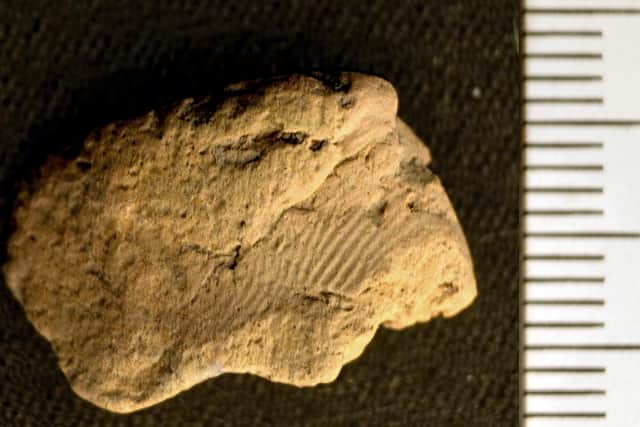Fingerprints of two young male potters found on 5,000-year-old Orkney vessel
Analysis of a fragment of ancient vessel found at Ness of Brodgar, a vast Neolithic cathedral-style complex, has illuminated an “unparalleled glimpse” into life at the remarkable site during the period.
In April, it was announced that a fingerprint was discovered on a clay vessel excavated from the site by a team led by the University of the Highlands and Islands Archaeology Institute.
Advertisement
Hide AdAdvertisement
Hide AdFurther scrutiny of a digital model created by ceramic specialist Jan Blatchford has now revealed another two prints, both belonging to two young men.


One maker is thought to have been aged between 13 and 20 with the second aged between 15 and 22 years old, analysis has shown.
Nick Card, the director of the Ness of Brodgar excavation, said the findings put the people back into the story of the Neolithic landscape.
He said: “With well over 80,000 pottery sherds found at the Ness of Brodgar, it can be all too easy to lose sight of the people behind them.
“This single sherd has brought two back into the spotlight and given us an unparalleled glimpse into life at the Ness complex 5,000 years ago. It also raises many questions.
"The creation of this pot involved an adolescent boy – did he fashion the vessel or was he just involved in the manufacturing process, perhaps overseen by a more experienced potter?
"Were all children engaged in the creation of pottery from an early age or was it a task that involved a select few? Were different types of vessel created by different people within the household or community?
“The analysis has much wider implications in the study of Neolithic ceramics, but we will need many more fingerprint examples before any firm conclusions can be drawn.”
Advertisement
Hide AdAdvertisement
Hide AdThe fingerprint findings were made by Professor Kent Fowler, director of the University of Manitoba’s Ceramic Technology Laboratory in Winnipeg, Canada, has found.
Prof Fowler said: “Although the prints exhibit identical average ages, there is little overlap in the ridge values between the two measured prints. This suggests one print was made by an adolescent male and the other by an adult male.
“Ethnographic and experimental accounts of hand-building techniques indicate that hands are normally only placed within closed-form vessels when fashioning roughouts and while manipulating the object to modify the exterior by wiping, smoothing burnishing.
"External prints can accrue during shaping or when handling the vessel after the roughout is completed, but when the clay is still leather hard and will accept prints. In this instance, it is most likely there were two print makers and the interior print was left by the potter.
"At this stage we cannot determine whether the older or younger potter was responsible for shaping operations.”
The Ness of Brodgar is the name of the thin strip of land, in the West Mainland of Orkney that separates the lochs of Harray and Stenness.
Click on the link for more information on the Ness of Brodgar.
A message from the Editor:
Thank you for reading this article. We're more reliant on your support than ever as the shift in consumer habits brought about by coronavirus impacts our advertisers.
If you haven't already, please consider supporting our trusted, fact-checked journalism by taking out a digital subscription.
Comments
Want to join the conversation? Please or to comment on this article.
